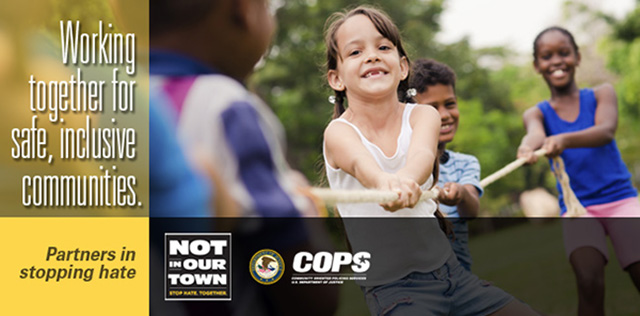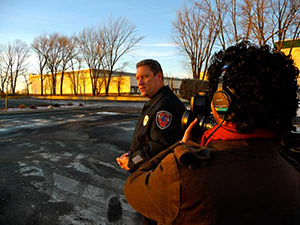Hate Crime Reporting – Working to Close the Gap

The COPS Office and Not In Our Town have joined forces to create vital new tools to help law enforcement professionals and community partners work together to prevent hate crimes, improve hate crime reporting, and address underlying tensions that can lead to violence. Over the next two years, ‘Not In Our Town: Working Together for Safe, Inclusive Communities’ project resources will include an online hub at www.NIOT.org/COPS, a series of new films and “Action Guides” highlighting successful practices, and a network of law enforcement leaders committed to spreading community policing strategies that promote safety and inclusion for all.
As the COPS Office and Not In Our Town launch a multi-year initiative to increase awareness of hate crimes, improve hate crime reporting, and promote safe, inclusive communities nationwide, a newly released study by the Department of Justice’s Bureau of Justice Statisticsi calls attention to the national gap in hate crime reporting and the importance of this project’s efforts to build a responsive law enforcement network of leaders to work toward bridging and closing this gap.
According to the DOJ study, more than 250,000 Americans over the age of 12 are victimized by hate crimes each year, and 92 percent of all hate crimes between 2007 and 2011 were violent. Despite the severity of these crimes, many went unreported.
The report notes that despite the rise in violent hate crime, the number reported to police declined from 46 percent in 2003–2006 to 36 percent in 2007–2011, even though the average number of violent or property hate crimes remained the same.
Why this reporting decline? The report surveyed victims and found that 24 percent of the responders in 2007–2011 said they did not report the crime because they did not believe the police could or would help. This is up from 14 percent in 2003–2006. Additionally, the number of responders who cited a fear of reprisal or getting the offender in trouble rose to 15 percent in 2007–2011 from 9 percent in 2003–2006.

These statistics point out the reluctance of many targeted groups to deal with police due to historical difficulties with police departments or a feeling that their interests will not be protected. This is exemplified by the film “Light in the Darkness,” one of a group of films produced by Not In Our Town. Here, the victimization of the Suffolk County, New York town of Patchogue’s Hispanic community by young men was widely known, but the attacks went unreported by the Hispanic community because of their lack of trust in the police department. This series of hate crimes culminated with the killing of Ecuadorian immigrant Marcelo Lucero.
This story points directly to the need for law enforcement to be leaders in this crisis and to form a solid leadership network to reach out to community partners and victims.
Yes it happened in their town, but the Suffolk County Police Department is trying to make sure it doesn’t happen again, and is also working with the Department of Justice to try to address the underlying issues. “We’ve implemented broad-based changes including enhanced hate crime training, community listening sessions for top brass, and a cadre of Hispanic, Spanish-speaking officers assigned to these communities,” said Chief of Department Jim Burke. “[With these methods] our hate crimes reporting stats have gone through the roof but there has been no fallout whatsoever.”
Burke noted that by following DOJ and NY State hate crimes reporting guidelines closely, the number of hate crimes reported may have gone up 300 percent from 2011–2012, but the net result was the department’s better rapport with many communities and a safer community for all its citizens.
Suffolk County is but one example of how improved policing practices build stronger and healthier communities. It is crucial that we spread community policing best practices, which build strong relationships between police agencies and the communities they serve, and focus on rebuilding mutual trust where fear or distrust have lingered.
The COPS Office and Not In Our Town are addressing this challenge directly with a series of new resources to help agencies initiate and enhance community policing strategies. Next month, we are releasing a joint publication outlining leadership strategies and actionable tactics titled Building Stronger, Safer Communities: A Guide for Law Enforcement and Community Partners to Prevent and Respond to Hate Crimes, which offers real-life examples of how agencies can work with community stakeholders to create an atmosphere where hate is not tolerated, and take positive steps in the aftermath of a hate crime. Among the featured case studies is the story of Billings, Montana, where Police Chief Wayne Inman led the outreach to community leaders when white supremacist activity increased in the early 1990s. Additionally, Suffolk County Detective Lola Quesada shares how she approached bridging the gap between the police and the immigrant community when she was assigned to work as the Hispanic community liaison after the killing of Marcelo Lucero. The guide also provides an extensive list of resources to promote action, engagement, and empowerment within the community.
Call for Leaders

The Not In Our Town: Working Together for Safe, Inclusive Communities initiative is looking for a few good leaders. We are building a network of 50 law enforcement leaders to serve in an advisory role to the greater law enforcement community and to build and spread the project and its tools. Are you willing to step up and take part in this national effort? If so, please visit www.cops.usdoj.gov/default.asp?Item=2679 or e-mail the NIOT Community Engagement Director at mgkloss@theworkinggroup.org.
Michelle Gahee Kloss, NIOT Director of Community Engagement
Libby McInerny, NIOT Director of Strategic Partnerships
i Nathan Sandholtz, Lynn Langton, Ph.D, and Michael Planty, Ph.D. 2013. Special Report: Hate Crime Victimization, 2003-2001. NCJ 241291. U.S. Department of Justice, Office of Justice Statistics, Bureau of Justice Statistics.
Hate Crime Reporting | New Ideas to Common Practices | MSP Youth Leadership Academy | Helping Hartford Prosper | 2013 L. Anthony Sutin Civic Imagination Award | IACP and CSCP Award

